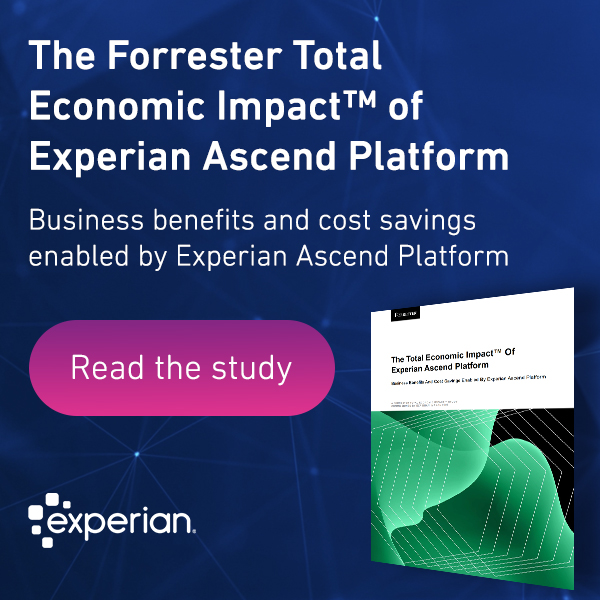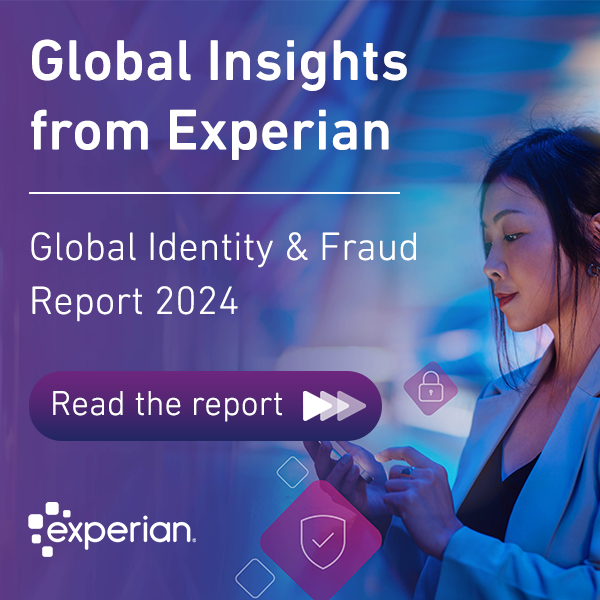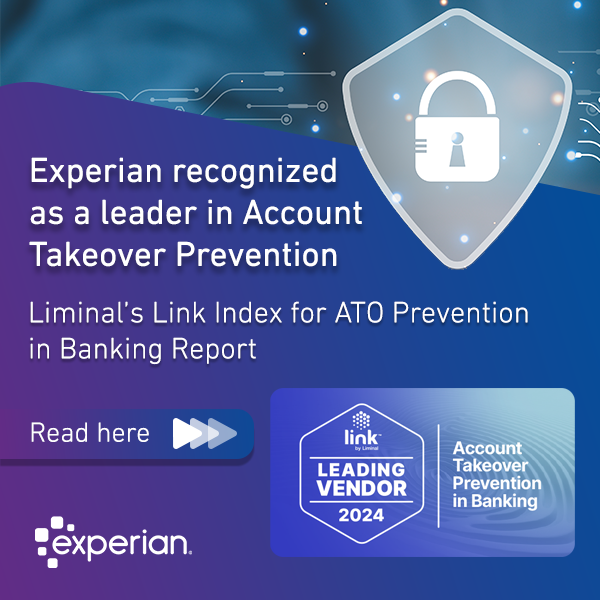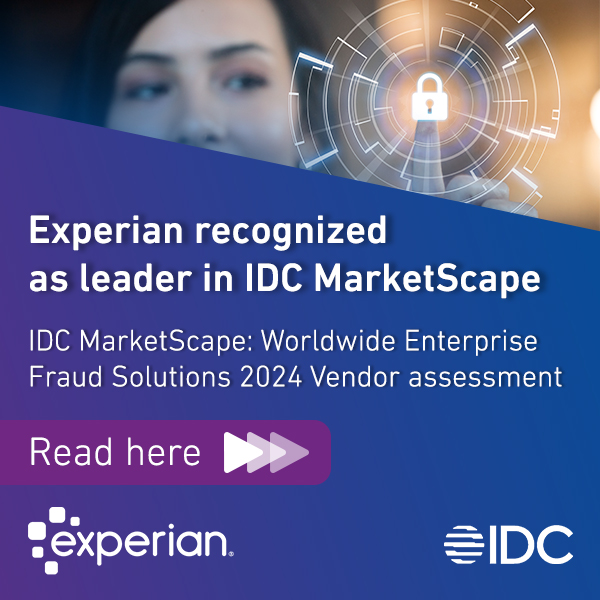Search Results for: DATA AI

Did you miss these April business headlines? We’ve compiled the top global news stories that you need to stay in-the-know on the latest hot topics and insights from our experts. Experian Named Top Provider of Digital Identity Juniper Research acknowledges Experian as an established leader in digital identity in its competitor leaderboard, highlighting the flagship identity and fraud platform, CrossCore™. The report also looks at the key areas of digital identity and where its headed. What’s the hardest part about using synthetic data correctly? Braintrust, Protocol's experts on the biggest questions in tech, talks to Eric Haller, VP and General Manager of Identity and Fraud and Datalabs, about using synthetic data and what challenges are involved in the process. Passwordless MFA: The Single Way To Mitigate the Top 5 Threats to Your Customer Identities As cyber criminals discover new methods to compromise consumer accounts, forward-thinking organizations are adopting solutions for better security and a smoother customer experience. Experian Finds Mobile Wallets Rival Traditional Payment Methods The new Experian Global Insights Report concludes that digital online spending will continue to gain strength even as consumers emerge from lockdown and return to in-person transactions. 6 e-commerce cyber fraud challenges in 2022 Mike Gross, VP Applied Fraud Research and Analytics, discusses the biggest cyber fraud trends predicted to come up in 2022. From deepfake fraud to fraud as a service, and the developing relationship between digital identity and verification with fraud detection. Stay in the know with our latest research and insights:

The evolving expectations and experience of the new digital consumer The expectations of consumers are changing rapidly. People of all ages and incomes are online, seeking the right products and services to manage their financial lives digitally in a secure, speedy, and frictionless environment. A look inside: Our latest research reveals the rise of a new digitally savvy consumer—one who is increasingly aware of new payment methods, advanced recognition tools, and the use of AI, and has higher expectations of their digital experience. Read the report to find out what businesses can do to harness the digital opportunity: 1. Leveraging the AI advantage 2. Incorporating embedded finance 3. Introducing new, more secure technologies 4. Educating consumers about how you use their data 5. Exploring solutions that aggregate emerging technologies Online spending is continuing its upward trend, with 53% of consumers surveyed saying they have increased online spending and transactions in the past three months, and 50% predicting that their spending will increase in the next three months. Enabling this shift is the extent to which businesses can provide a quality digital experience. 81% of consumers said that a positive online experience, which includes interactions with multiple digital touchpoints makes them think more highly of a brand. Consumers simply do not tolerate poor-quality online experiences and will take their loyalty to businesses that can meet their expectations. Speed and security are a driving force for consumers in the payments space, which is reflected in rapid rise in mobile wallet payments. Rivalling traditional payment methods, 62% of consumers say they’ve used a mobile wallet in the last six months. Consumers are embracing these new habits across the board, with 18% saying they have used BNPL in the past six months, and 71% seeing it as secure. With the rise and increasing awareness of new payment methods like BNPL, consumers who have lacked access to traditional banking, lending and credit cards now have additional financial options, giving businesses the opportunity to prioritise financial inclusion. The rise of new and increased online activity has resulted in increased concerns about online security, with 42% of consumers more concerned than they were 12 months ago. With this awareness comes opportunity for businesses to leverage new recognition approaches. Biometrics seems to resonate with consumers, with 81% reporting that they feel most secure when encountering physical biometrics. Trust and security are becoming interdependent, with consumers expecting strong security measures from businesses. 73% of consumers say that the onus is on businesses to protect them online, and 45% identify the belief that businesses have strong security measures in place as the top reason to trust an online transaction. As consumers become ever-more educated and aware of the digital world, they want businesses to communicate with them about why they are using personal data. 63% of consumers are willing to share their data and see it as beneficial to them if they see security and convenience in return. We surveyed 6,000 consumers and 2,000 businesses from 20 countries worldwide as part of our ongoing efforts to learn more about how, why, and where consumers interact with businesses online. Read the full report Stay in the know with our latest research and insights:

Did you miss these March business headlines? We’ve compiled the top global news stories that you need to stay in-the-know on the latest hot topics and insights from our experts. Experian partners with Black Opal to bring credit options to US immigrants PYMNTS.com covers the partnership between Experian and Black Opal to boost consumer credit access to immigrants in the US. Using Crosscore and PowerCurve, Block Opal will be able to make real-time credit decisions while also managing using the platform’s tools to better manage identity verification and fraud prevention. Fraud shifting as online activity increases In this CUNA article, Brock Fritz explores Experian's Future of Fraud Index for 2022, with Experian's Chief Innovation Officer, Kathleen Peters, offering up solutions for businesses looking to mitigate the effects of more online fraud. How AI is modernizing online transactions Donna DePasquale, EVP of Global Decisioning Software, writes in Dataversity about the importance of automation and insights as objectives driving modernization through AI for businesses, and what they should focus on in order to increase customer acquisition. Online payment fraud Online payment fraud will reach 206 Billion by 2025. David Britton, Experian VP Industry Solutions Global Identity and Fraud is interviewed by David Cogan, host of the Heroes Show and founder of Eliances entrepreneur community. Stay in the know with our latest research and insights:

Did you miss these January business headlines? We’ve compiled the top global news stories that you need to stay in-the-know on the latest hot topics and insights from our experts. Next-gen AI analytic apps in credit In this Lendit Fintech webinar about the future of AI analytics in credit, Srikanth Geedipalli, SVP of Global analytics and AI, joins a panel of experts to explain how Experian deals with delinquencies and retains customers using a proactive approach. A successful DevOps strategy is more than just technology Dr Mark D. Spiteri writes on the Forbes Technology Council about how Experian has embraced DevOps culture to not only improve internal IT processes, but also to reshape the mindset of product development teams. 7 payments trends for 2022 as innovation climbs David Bernard, SVP Global Decision Analytics, talks to Payments Dive about cross-border services, BNPL and cybersecurity tools, and how there will be no shortage of innovation and competition in the payments industry as businesses and their regulators shape new digital tools. Deepfakes – the good, the Bad, and the ugly In this Forbes article, Eric Haller, VP & General Manager, Identity, Fraud & DataLabs, talks about how the creation of deepfakes can be thought of as the latest development in the ongoing battle between business and counterfeiting. Stay in the know with our latest research and insights:

One of the most exciting things about financial services innovation is our growing ability to deliver personalized customer experiences. For example, consider a customer who enters a shopping center during the holiday season. By leveraging decisioning software, lenders can proactively offer that customer more credit—in real-time. The person has the financial ability to get what they need and doesn't have to experience a rejected transaction based on previous credit availability. What's behind such personalized offers? They are powered by the latest data—information that goes far beyond traditional credit ratings and references. For the holiday shopper, that may include geolocalization and behavior data that project a customer's likelihood of reaching a credit limit while shopping. The information empowers lenders to provide that personalized experience at the exact right time. But to make that possible, the data must be interoperable across systems, analytical and operational environments, and third-party data providers. Looking ahead, the financial service companies that enable this interoperability will be able to innovate faster, compete better, and scale their personalization to ultimately win more business. Why interoperability matters Our most recent Global Decisioning Research Report denotes consumers' evolving expectations and the increasingly vital role data and analytics play in meeting their needs. Financial service companies must leverage data to understand customer circumstances better, changing risk profiles and emerging credit needs, especially as we move out of the pandemic. Indeed the right data can help lenders support customers across their entire journey. But utilizing data to improve the customer experience is not as straightforward as it seems. The amount and diversity of the data available are huge. And the data required to power personalized products and experiences are not always readily accessible, well-formed, or high quality. As a result, data integration projects often take longer and cost more than many financial service companies anticipate. Legacy systems add to the complexity and expense. The evolving open standards for data interoperability are helping alleviate some of these challenges. But companies still need to determine which standards and platforms to use. Selecting the right ones can accelerate innovation and prevent expensive stops, starts, and detours down the road. Cultivating a healthy ecosystem The good news is that these challenges are surmountable. The first step is to understand where your organization is in its data interoperability journey. Then you can create a strategy that makes data-based innovation easier, faster, and more cost-effective. For example, consider: Prioritizing industry-leading open standards for interoperability. Requiring CSV and JSON data formats is smart; both are currently ubiquitous across the industry. Using standard APIs to share data. For example, Rest APIs using Swagger provide a description of the API, the data and facilitate the discoverability and use of the API. Exploring API aggregation services and marketplace platforms. These make it easy for developers to add services and for your organization to put them to use. Leveraging low-code data integration tooling. This helps you remove data silos and empower staff to navigate older, traditional data integration methods until they evolve to use open standards. These actions can make a significant impact on your company's ability to take advantage of various data sources now, as well as set your organization up for the future. Data meets decisioning Selecting the right decisioning software is a crucial way to facilitate the steps noted above. As you consider decisioning solutions, look for products that allow you to publish and consume data using open APIs and simple visual drag and drop approaches. In addition, evaluate the core data management capabilities of potential solutions, and prioritize those that can natively also support semi-structured data. For instance, applications that allow you to leverage frequently changing data sources ensure that when a source evolves, only the specific areas loading the data are impacted—not the wider solution. Lastly, as mentioned above, solutions that provide lightweight, low-code middleware allow you to leverage third-party data no matter where you’re at in your interoperability journey. Those new sources of data will inform and enhance your customer's experience. Stay in the know with our latest research and insights:

Did you miss these September business headlines? We’ve compiled the top global news stories that you need to stay in-the-know on the latest hot topics and insights from our experts. Lending in a Two-Lane Economy Harry Singh, Senior VP, Global Decisioning, features on this CU Management podcast, discussing ways in which Credit Unions can best serve their customers with loans and other products within what Experian's latest research refers to as the two-lane economy. The deepfake-scape: How to fight fraud in the digital age This Biometric Update article by David Britton, VP of Industry Solutions, looks at why deepfakes are a big risk to businesses and consumers, and how fighting fire with fire in the form of artificial intelligence and machine learning can be the best form of defence for organizations. Focus on Data, Advanced Analytics and Decisioning Creates a Winning Strategy for Experian Global Banking and Finance announce that Experian has been ranked number 11 in the IDC FinTech Rankings Top 100 which highlights the top 100 global providers of financial technology, with the piece referring to Experian as a “rising star.” The Rise Of Voice Cloning And DeepFakes In The Disinformation Wars Forbes's Jennifer Kite-Powell uncovers that although deepfake fraud is dominant in social media, it is quickly moving into business sectors. Kite-Powell talks to David Britton, VP of Industry Solutions, about what businesses can do to counteract deepfake fraud tactics like voice-cloning. Shri Santhanam talks AI in lending On this Fintech One to One podcast from Lendit FinTech News, Shri Santhanam, Global Head of Advanced Analytics and AI, talks about how lenders in the FinTech space should be using AI and machine learning, and what key trends he has encountered through the years, and what we might expect to see in the future. Stay in the know with our latest insights:

Getting the most out of your AI investment Work backward from impact - give yourself room to experiment Hire the best data talent and partner with the right provider Take a holistic approach - don't just focus on performance AI allows businesses to process sheer volumes of data and multi-tiered models with extreme speed and efficiency. But, scaling AI to meet shifting business demand can be challenging. Experian's Ascend Intelligence Services expertly partners with organizations to build custom, scalable AI and ML solutions to meet those requirements. Listen to Shri Santhanam advise on how to scale AI

How elite leaders train analytics teams to unearth and convey the highest quality data insights and better manage risk. It's surprising how much of an art the effective use and analysis of qualitative data in the business world truly is. Too often, data scientists are tasked with turning raw data into insights without ever actually being taught the true art of identifying and reporting the most meaningful insights that address the problems at hand. Instead, data teams often produce reams of summarized information without drawing any useful conclusions – falling short of discovering deeper truths hidden within. I've been fortunate to work for, with, and manage data scientists of various titles, abilities, and personalities over the years. I've found that the true "artists" in this profession can combine technical proficiency, tactical communications with an affinity for the science, and excellent detective skills. Objectivity in Data Analysis As Arthur Conan Doyle wrote in Sherlock Holmes says, "I never guess. It is a capital mistake to theorize before one has correct data. Insensibly one begins to twist facts to suit theories, instead of theories to suit facts." As data scientists, we're often sent down a singular path to analyze data to support a narrative. Data is inherently objective; analyzing with subjective intent typically leads to ineffective results when put into practice. However, with the proper guidance, probing questions, and some detective work, scientists can uncover deeper insights leading to effective outcomes in the form of actionable intelligence and forecasts. Early in my career, I was tasked by a business partner to pull data that demonstrated higher customer satisfaction scores for a customer call center. Requests like this – "just get me the data" – are (unfortunately) common. In this case, however, he was open to discussing the "why" behind his ask. As a result, this incident proved a learning opportunity for me on how to satisfy a requirement while simultaneously producing information explicitly valuable to the organization. I've often had to find workable paths through figurative minefields with mandates such as "just get me the data" or "make the numbers work." During this scenario, I diligently asked ancillary questions to build into the data modeling outside the required parameters. I intended to generate value beyond the pre-conceived conclusion I was tasked with finding data for. The resulting report yielded compelling insights, actionable intelligence, and a clear forecasting plan. In this example, it was found that clients had higher satisfaction scores for reasons other than what we initially thought and had nothing to do with the seven million dollars my business partner spent on branding, training, etc. The solution was simple: move a training location. Tactical communication skills were necessary in this scenario as I had to tell my business partner where the efficiency gains were actually coming from and where future budgets could be more effective. Doing so was the catalyst behind an alternative business strategy and focus, resulting in a much more significant impact on our customer relationships. Asking the Right Questions The true purpose of analytics is to discover, interpret, and communicate meaningful patterns in data and the connective tissue between. Most importantly, it exists to aid in effective decision-making within an organization. Under that premise, I teach my teams to be communicative, especially during planning stages and consistently ask questions of the data throughout the analytical process. It's always imperative to identify the specific addressable problems our clients are trying to solve while frequently conversing with them to understand what actions and/or decisions the analysis is meant to inform. This strategy produces more profound results and focuses on solving a problem – not endlessly cycling through various cuts of the same data. As a result, the team will be primed to evaluate results objectively and be ready to dig beyond surface-level data, capturing vital insights hidden deep within. Using the Right Tools Nobody does arithmetic by hand anymore. A data scientist's best friend should be sophisticated model development software that leverages AI and Machine Learning. The efficiency they provide enables us to focus on areas where human intelligence is best applied, such as interpreting model performance within the context of how that model will be used. Elite leaders know how to leverage the right tools to maximize speed and efficiency. Ignoring the sheer processing power of cloud computing and other advancements places your organization at a distinct competitive disadvantage in performance and accuracy. I shudder when thinking about the dark days when it would take six to nine months to develop a new model. It reminds me of watching NASA mathematicians do advance calculations with slide rules in movies like Apollo 13 and Hidden Figures. Strategy optimization is a perfect example; how do I ensure that my portfolio is holistically delivering the highest value within risk constraints? I could grow my portfolio endlessly, but that likely means taking on too much back-end risk. Instead, mathematical optimization can be used to determine the right balance between growth, return, and risk. To do this successfully requires a vast amount of processing power. Gradient boosting, a Machine Learning technique that helps build far more accurate models, is another excellent example of what's possible with modern technology. Some of the operations we perform daily were literally not possible 10-15 years ago as we did not have access to such processing power. Thus, we're able to solve problems not previously solvable. What has also changed is our ability to process volumes of data and highly complicated, multi-tiered models, with extreme speed and efficiency. Organizations don't need to take all of this on, as companies like Experian effectively provide data science services where AI/ML solutions are delivered rapidly and digitally. A well-equipped, efficient, curious, and well-trained data team whose data analysis consistently helps corporate leaders make informed decisions is true art. The answers they provide to challenging business questions is their magnum opus. Read about topics related to this article Stay in the know with our latest research and insights:
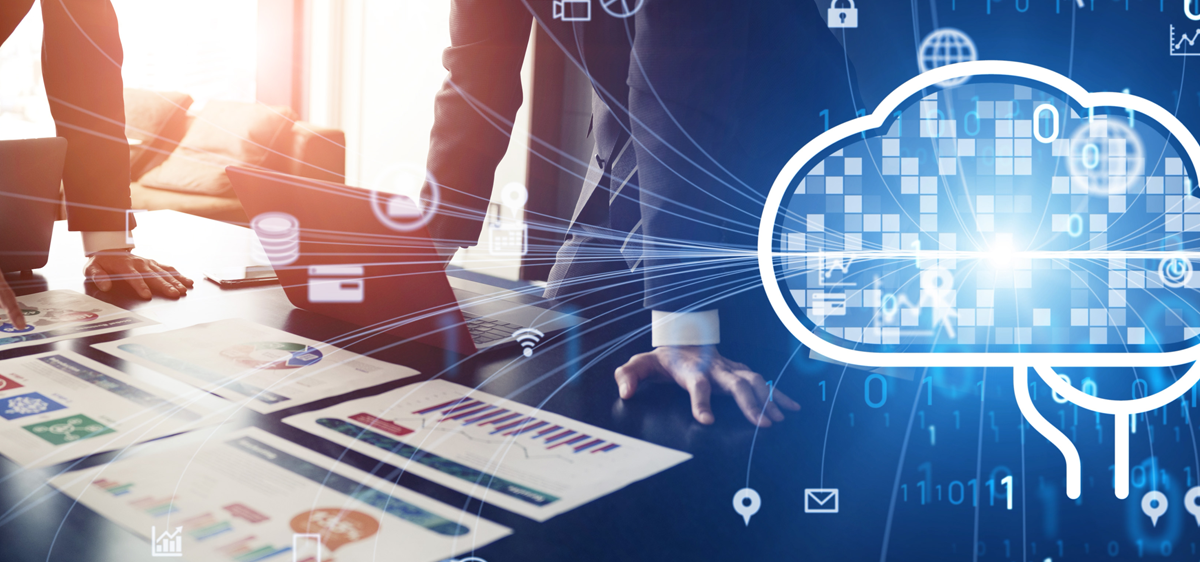
Shri Santhanam, EVP and Global Head of Analytics and AI, talks to Ganesh Padmanabhan from Stories in AI about why he hopes the changing world of lending will lead to better financial inclusion. "The whole digital revolution in lending means that financial institutions are scrambling to make the process much more seamless, reduce time for approvals, let consumers have access to different financial products, and have innovative products like buy now pay later. But underneath it all, you have to get more nuanced and more sophisticated about the methodologies that you use for lending. And this is where AI and ML come in." Expect to hear discussions about the future of finance, how to drive impact by leveraging data analytics and AI, frameworks for setting up and institutionalizing an AI center of competence for a large organization, and how to scale data science efforts through hiring, promoting from within, and setting up the right structure and processes to make it happen. "Experian for over 100 years now has leveraged the power of data. We’ve been a very powerful data company. We’ve used that data to improve the lives of consumers and improve how businesses make decisions. Fundamentally, we’ve had a set of pioneers who before Big Data tech was introduced to the world, figured out that having a data marketplace or collecting high quality data on consumer lending will be of value, and that’s been the core of our business. That dynamic is changing. We see a lot of value migrating what we call up the stack. So from purely data to actually the decisions that are made with the data, to products and services in the data." Related content

Credit providers have long relied on data to lend insights into how their customers are faring—and help predict what's to come. The pandemic, however, introduced unexpected anomalies that have made understanding the actual credit landscape far more challenging. For example, while government assistance programs have enabled customers to stay up-to-date on their payments, they've also made it harder to discern the true financial impacts of the crisis. Our recent research gives voice to these challenges. We surveyed businesses around the world three times from July 2020 through January 2021 for our annual Global Decisioning Report. The results reveal that business confidence in credit risk analytics models has declined over the pandemic, dropping by nine percentage points for Tier 1 lenders, and 15 percentage points for Tier 3 lenders. As we look ahead, credit providers need ways to improve confidence in their analytics models so that that they can make smarter, faster decisions on behalf of their customers and businesses. This is where synthetic and alternative data are beginning to make a real difference. The rise of AI and machine learning solutions has opened the door for lenders to leverage this data. Understanding how to put it to use—and why it's imperative to do so—will help lenders navigate the end of this crisis and prepare them for any economic volatility in the future. The data differentiator Before we dive into how lenders can best utilize alternative and synthetic data, let's quickly define what we're discussing. Credit providers have traditionally used credit bureau data to assess their portfolio risk and inform credit decisions. But as noted, in times of crisis, supplementing that data with additional context can significantly improve its effectiveness. Alternative data does just that. Alternative data refers to primarily unstructured data from non-traditional sources. For example, social media data can help paint a more complete picture of customer behavior. And location data can provide information about customer geography, such as opportunities for travel-related purchases. Synthetic data complements alternative data but is not the same. Synthetic data is new data created by altering existing data. So a lender might change the profile of its customer base and then use that dataset in analytics models to better understand what the future may hold. Both types of data work together, with alternative data providing a more complete customer view and synthetic data allowing lenders to account for additional variables and offset their risk accordingly. New data in action Confidence in analytics models may have dropped during the crisis. But lenders aren't resting on their laurels. Instead, nearly half of businesses report that they are dedicating resources to enhance their analytics efforts. Those that include alternative and synthetic data in their improved models have the opportunity to leverage the information in multiple ways. Some of the most exciting applications of alternative and synthetic data include: Anticipating purchasing behavior New data sources, especially from social media, help lenders understand what's happening in their customers' lives and how that may translate into purchases. For example, a customer who has recently moved into a new home may be considering purchasing furniture or home décor. Or customers who are celebrating life milestones such as birthdays or graduations may be buying gifts or spending on events. Predicting credit risk In this realm, synthetic data can be beneficial. Lenders can use synthetic data to understand how credit profiles may change in specific circumstances, such as modeling a higher unemployment rate or dramatic income shifts. They can then use analytics models to determine the related impact on customer affordability. Improving fraud detection With an improved customer view, fraud prevention teams can more easily identify unusual patterns in customer behavior and spending. For instance, does a customer's current location (per location data) match their most recent transactions? Or has the number of contacts on their phone dramatically changed (it may not be their phone)? Enhancing pricing Both types of data are useful in improving pricing models across company portfolios and at a personal level. The additional context can help everyone from lenders to insurers to banks assess customer needs and provide products that meet them—at prices that make sense. What's more, machine learning automates that pricing, allowing companies to scale personalization across the organization. Improving marketing In the same vein, new sources of data can also give marketing efforts a boost. The ability to access more real-time information about customer behaviors uncovers opportunities to provide them with credit, insurance, and other lending products that may prove immediately helpful. Data can also help identify new markets entirely or highlight rising needs that may demand the development of additional products or services. The past year was an anomaly in so many ways. However, as we ease out of the crisis, financial service companies have the opportunity to strengthen their data models—and leverage new types of data to reduce their risk and provide improved decisioning no matter what the future holds.

As we enter the beginning of the end of this global crisis, the role of data, analytics, and credit risk decisioning takes on even greater significance than before. Consumers face uneven roads to recovery, with some ready to spend again and others still mired in pandemic-related financial stress. And businesses of all sizes report their operations are recovering but there’s still a way to go. A key difference we saw is that companies that adapted to serve customer needs digitally are faring much better. Our 2021 Global Decisioning eBook, Navigating a new era of credit risk decisioning, looks at how consumers are stabilizing their finances and how businesses are returning to growth. A recent survey among 9,000 consumers and 2,700 businesses across ten countries worldwide reveals the importance of lenders prioritizing digital transformation, and the role of advanced data and analytics in enhancing the customer experience. The pandemic fall-out is impacting everyone differently: 1 in 3 consumers remains concerned about their finances – paying bills and managing credit Whereas high-income households are no longer reducing their discretionary spending Navigating this varied credit landscape requires a deep understanding of customer needs on both ends of the spectrum. However, business confidence in the consumer credit risk management analytics models dropped over the past year from 71 percent to 61 percent. Smaller lenders with revenues ranging from $10M to $49M have seen the sharpest decline from 72 percent to 57 percent in the past six months. Adapting data and analytics to a rapidly changing customer base: Almost 50% of businesses surveyed said their dedicate more resources to enhance analytics One-third of businesses are planning to re-build their models from scratch Recalibrating credit models is one thing, but lenders also need to rethink their data sources to better understand current customer profiles. The data inputs generated by the pandemic have impacted credit risk models and machine learning applications in unexpected ways. For example, widespread payment holidays and government stimulus programs may be masking customers’ true financial circumstances. According to Recovery Insights, a separate study published by Experian North America: Delinquency prior to the pandemic is a strong indicator of future risk. Accounts exiting an accommodation period are 2x more likely to become delinquent than are accounts that never received an accommodation. Payment on debt during accommodation indicated a reduced risk for subsequent delinquency. Amidst the pandemic lockdown, consumers turned online to manage finances and connect with lenders – including older consumers. And while the pandemic pushed consumers online out of necessity, now that they’re there – it’s become a preference – as overall digital gains are holding above pre-pandemic levels. Lenders have a new digital imperative to meet consumers’ evolving needs for continued digital engagement. Consumer expectations of digital experiences 55% of consumers have higher expectations of their digital experience since Covid-19 began 43% of consumers surveyed age 70+ reported digital banking throughout the pandemic 14% of consumers surveyed age 60-69 applied for a new loan or card online The importance of a digital-first approach has revealed itself and many companies have put a digital customer journey in place since Covid-19 began. The future, however, is more than providing online services. It’s about knowing your customers well enough to anticipate their credit needs and using tools to automate the process and reduce risk. Adapt or lose customers 9 in 10 businesses have a digital customer journey in place 1 in 4 consumers have taken their business elsewhere because a company didn’t adapt to their digital needs Online customer experience and credit risk management are more connected than ever before. And, businesses need technology that supports the entire customer journey, from onboarding to customer management to collections. Five digital investments businesses are prioritizing the new era of credit risk management: Implement new machine learning models for customer decisions Increase digital acquisitions and engagement Understand their customer base (affordability, value, behavior) Automate customer decisions Increase value of existing customers Access the report here to get more consumer trends and find out what the future of decisioning means for businesses looking to return to growth. Stay in the know with our latest insights:

The surge in digital demand over the past year reinforced the deep connection between recognition, fraud prevention, and the online customer experience. As businesses transformed their operations to accommodate the rapidly growing volume of digital transactions, consumer expectations for easy, secure interactions increased at an even faster pace. And that meant less tolerance for the interruptions caused by security and risk controls. Our 5th Annual Global Identity and Fraud Report highlights these shifts and more, drawing on three waves of data collected throughout the pandemic. The business and consumer surveys took place in waves from June 2020 to January 2021 across 10 countries spanning North America, Latin America, Europe, and Asia-Pacific. The breadth of data reveals notable changes in consumer and business behavior and priorities as each navigated the crisis. One of the many heartening discoveries included the fact that 8 in 10 businesses said that they now have a customer recognition strategy in place, up 26% since the start of the pandemic. Many companies also developed digital strategies as they strove to improve their online experience and provide security and fraud prevention measures when customers needed it most. When it comes to fraud prevention, companies are continuing to invest in securing online experiences. This is an encouraging trend, especially given that we anticipate fraud attacks will increase significantly in the near term. Here are some key consumer trends from the 5th Annual Global Identity & Fraud Report: Consumer digital trends and behaviors As of January 2021, 43% of consumers plan to increase their banking and shopping transactions in the next 12 months 60% of consumers globally have used a universal mobile wallet, a +7%-pts increase since the pandemic began and highest (66%) among under 40s 55% of consumers say security is their top priority online. This has been the case for the past 5 years of our study, with privacy (23%) second. Consumer concerns for fraud 44% of consumers globally said they were most concerned about protecting credit cards and bank account details 1 in 4 consumers (only 23%) were concerned about protecting personal data e.g. date of birth, address, and SSN or equivalent 33% of consumers are worried about identity theft compared to 28% of consumers who were worried about it before the pandemic Consumer preferences are shifting towards invisible security 74% of consumers prefer the security of physical biometrics, which is most applicable to mobile devices and include facial recognition and fingerprints 72% of consumers prefer the security of PIN codes, requiring the use of two devices, each connected to the users’ account 66% of consumers prefer the security of behavioral biometrics, which is passively observed signals across browsers/ devices requiring no effort from the consumer Even as businesses prioritize the customer experience and support, our research found that they’re still sustaining pre-pandemic levels of investment in security and fraud management. Access the report here to get more consumer trends and find out what businesses are focusing their investments to improve their customer’s digital experience, including fraud prevention.
